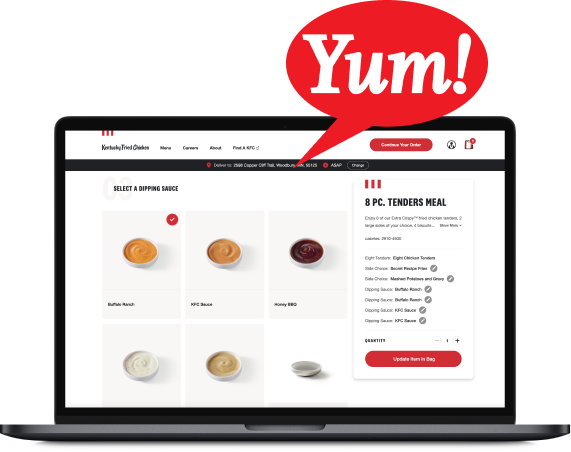Passing Props page
Learn how to provide information to a component through props.
Overview
- Learn about passing data to components using props.
Objective 1: Use and set props
In this section, we will:
- Understand what props are and how they work in React
- Define a component's props using TypeScript interfaces
- Use props within a child component
- Pass props from a parent component to a child component
Using component props
In React, props (short for “properties”) are how we pass data from a parent component to a child component. Since functional React components are “just” JavaScript functions, you can think of props like the arguments you pass to a function.
To receive props, functional components must implement a React API that
allows an optional argument of type object that's named "props".
The properties on the props object—individually called a “prop”—can include whatever data the child component needs to make the component work. The property values can be any type, including functions and other React components.
We're using TypeScript in our project so we can create an interface for props
and use it in the definition of a functional component. Let's create a SubmitButton
component to see props in action:
interface SubmitButtonProps {
label: string;
onClick: () => void;
}
const SubmitButton: React.FC<SubmitButtonProps> = (props) => {
const { label, onClick } = props;
return <button onClick={onClick} type="submit">{label}</button>;
}
In this example, SubmitButtonProps is an interface that defines the types for
label (a string) and onClick (a function). Our SubmitButton component then
uses these props to display a button with a label and a click action.
The example above illustrates how props are passed to component as an argument. However, more commonly (and for the rest of this course) you will see props destructured in the function parameters:
interface SubmitButtonProps {
label: string;
onClick: () => void;
}
const SubmitButton: React.FC<SubmitButtonProps> = ({ label, onClick }) => {
return <button onClick={onClick}>{label}</button>;
}
Passing component props
Now, how do we use this SubmitButton?
In JSX syntax a component's props look like an HTML tag's
"attributes" and accept a value.
- If a prop's value type is a string then the prop value is set using quotes.
- Any other type of prop value is set using braces with the value inside.
In the
example below, the label prop accepts a string. so the value is surrounded
by double quotes. The onClick prop accepts a function, so the function value
is surrounded by braces.
Here’s how to use our SubmitButton:
<SubmitButton
label="Activate"
onClick={() => alert("Activated!")}
/>
In the example above, we’re setting the label prop to the string “Activate” and the
onClick prop to a function that displays an alert.
Reserved prop names
There are two prop names that you cannot use and are reserved by React:
children: this prop is automatically provided by React to every component. We will see this prop in later examples.key: this prop is one you’ve seen in a previous section! It’s not actually part of the component’s props in a traditional sense. Instead, it’s used by React itself to manage lists of elements and identify which items have changed, been added, or been removed.
Setup
✏️ Create src/pages/RestaurantList/ListItem.tsx and update it to contain:
interface ListItemProps {
address?: {
city: string;
state: string;
street: string;
zip: string;
};
name: string;
slug: string;
thumbnail: string;
}
const ListItem: React.FC<ListItemProps> = () => {
return (
<>
</>
)
}
export default ListItem
✏️ Update src/pages/RestaurantList/RestaurantList.tsx to import ListItem:
import CheeseThumbnail from 'place-my-order-assets/images/2-thumbnail.jpg'
import PoutineThumbnail from 'place-my-order-assets/images/4-thumbnail.jpg'
import ListItem from './ListItem'
const RestaurantList: React.FC = () => {
const restaurants = {
data: [
{
name: 'Cheese Curd City',
slug: 'cheese-curd-city',
images: {
thumbnail: CheeseThumbnail,
},
address: {
street: '2451 W Washburne Ave',
city: 'Green Bay',
state: 'WI',
zip: '53295',
},
_id: 'Ar0qBJHxM3ecOhcr',
},
{
name: 'Poutine Palace',
slug: 'poutine-palace',
images: {
thumbnail: PoutineThumbnail,
},
address: {
street: '230 W Kinzie Street',
city: 'Green Bay',
state: 'WI',
zip: '53205',
},
_id: '3ZOZyTY1LH26LnVw',
},
]
};
return (
<>
<div className="restaurants">
<h2 className="page-header">Restaurants</h2>
{restaurants.data ? (
restaurants.data.map(({ _id, address, images, name, slug }) => (
<div key={_id} className="restaurant">
<img src={images.thumbnail} alt="" width="100" height="100" />
<h3>{name}</h3>
{address && (
<div className="address">
{address.street}
<br />
{address.city}, {address.state} {address.zip}
</div>
)}
<div className="hours-price">
$$$
<br />
Hours: M-F 10am-11pm
<span className="open-now">Open Now</span>
</div>
<a className="btn" href={`/restaurants/${slug}`}>
Details
</a>
<br />
</div>
))
) : (
<p>No restaurants.</p>
)}
</div>
</>
)
}
export default RestaurantList
Verify
These tests will pass when the solution has been implemented properly.
✏️ Create src/pages/RestaurantList/ListItem.test.tsx and update it to be:
import '@testing-library/jest-dom';
import { render, screen } from '@testing-library/react';
import { describe, expect, it } from 'vitest';
import ListItem from './ListItem';
describe('ListItem component', () => {
it('renders the restaurant image', () => {
render(<ListItem slug="test-slug" name="Test Name" thumbnail="test-thumbnail.jpg" />);
const img = screen.getByRole('img');
expect(img).toHaveAttribute('src', '/test-thumbnail.jpg');
expect(img).toHaveAttribute('width', '100');
expect(img).toHaveAttribute('height', '100');
});
it('renders the address', () => {
const address = {
city: 'Test City',
state: 'Test State',
street: 'Test Street',
zip: '12345',
};
render(<ListItem slug="test-slug" name="Test Name" address={address} thumbnail="test-thumbnail.jpg" />);
const addressDiv = screen.getByText(/Test Street/i).closest('div');
expect(addressDiv).toHaveTextContent('Test Street');
expect(addressDiv).toHaveTextContent('Test City, Test State 12345');
});
it('does not render the address section when address is not provided', () => {
render(<ListItem slug="test-slug" name="Test Name" thumbnail="test-thumbnail.jpg" />);
// Check that address-related text is not in the document
expect(screen.queryByText('Test Street')).not.toBeInTheDocument();
expect(screen.queryByText(/Test City, Test State 12345/)).not.toBeInTheDocument();
});
it('renders the hours and price information', () => {
render(<ListItem slug="test-slug" name="Test Name" thumbnail="test-thumbnail.jpg" />);
const hoursPriceDiv = screen.getByText(/\$\$\$/i).closest('div');
expect(hoursPriceDiv).toHaveTextContent('$$$');
expect(hoursPriceDiv).toHaveTextContent('Hours: M-F 10am-11pm');
});
it('indicates if the restaurant is open now', () => {
render(<ListItem slug="test-slug" name="Test Name" thumbnail="test-thumbnail.jpg" />);
expect(screen.getByText('Open Now')).toBeInTheDocument();
});
it('renders the details button with correct link', () => {
render(<ListItem slug="test-slug" name="Test Name" thumbnail="test-thumbnail.jpg" />);
const detailsButton = screen.getByRole('link');
expect(detailsButton).toHaveAttribute('href', '/restaurants/test-slug');
expect(screen.getByText('Details')).toBeInTheDocument();
});
});
Exercise
- Update
ListItemto accept props with restaurant data. - Alter
ListItemto return the JSX for a single item inrestaurants.data, use props for the variable data. - Refactor
RestaurantListto useListItemto render the items inrestaurants.data.
Having issues with your local setup? You can use either StackBlitz or CodeSandbox to do this exercise in an online code editor.
Solution
Click to see the solution
✏️ Update src/pages/RestaurantList/ListItem.tsx to be:
interface ListItemProps {
address?: {
city: string;
state: string;
street: string;
zip: string;
};
name: string;
slug: string;
thumbnail: string;
}
const ListItem: React.FC<ListItemProps> = ({ address, name, slug, thumbnail }) => {
return (
<>
<div className="restaurant">
<img src={`/${thumbnail}`} alt="" width="100" height="100" />
<h3>{name}</h3>
{address && (
<div className="address">
{address.street}
<br />
{address.city}, {address.state} {address.zip}
</div>
)}
<div className="hours-price">
$$$
<br />
Hours: M-F 10am-11pm
<span className="open-now">Open Now</span>
</div>
<a className="btn" href={`/restaurants/${slug}`}>
Details
</a>
<br />
</div>
</>
)
}
export default ListItem
✏️ Update src/pages/RestaurantList/RestaurantList.tsx to be:
import CheeseThumbnail from 'place-my-order-assets/images/2-thumbnail.jpg'
import PoutineThumbnail from 'place-my-order-assets/images/4-thumbnail.jpg'
import ListItem from './ListItem'
const RestaurantList: React.FC = () => {
const restaurants = {
data: [
{
name: 'Cheese Curd City',
slug: 'cheese-curd-city',
images: {
thumbnail: CheeseThumbnail,
},
address: {
street: '2451 W Washburne Ave',
city: 'Green Bay',
state: 'WI',
zip: '53295',
},
_id: 'Ar0qBJHxM3ecOhcr',
},
{
name: 'Poutine Palace',
slug: 'poutine-palace',
images: {
thumbnail: PoutineThumbnail,
},
address: {
street: '230 W Kinzie Street',
city: 'Green Bay',
state: 'WI',
zip: '53205',
},
_id: '3ZOZyTY1LH26LnVw',
},
]
};
return (
<>
<div className="restaurants">
<h2 className="page-header">Restaurants</h2>
{restaurants.data ? (
restaurants.data.map(({ _id, address, images, name, slug }) => (
<ListItem
key={_id}
address={address}
name={name}
slug={slug}
thumbnail={images.thumbnail}
/>
))
) : (
<p>No restaurants.</p>
)}
</div>
</>
)
}
export default RestaurantList

